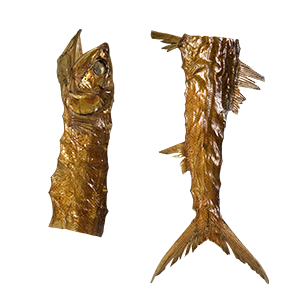 In 1763, this ladyfish almost became a meal—it even had its scales removed in preparation for dinner—before instead entering biology’s hall of fame as a type specimen, or the first fleshy representative of its species. Could it have been prepared by an enslaved chef?
In 1763, this ladyfish almost became a meal—it even had its scales removed in preparation for dinner—before instead entering biology’s hall of fame as a type specimen, or the first fleshy representative of its species. Could it have been prepared by an enslaved chef?
Alexander Garden, a Scottish naturalist based in South Carolina who supplied the famed Swedish naturalist Carl Linnaeus with a steady stream of specimens from the New World, received the ladyfish from a local gentleman. According to Garden, the man had “unluckily ordered it to be dressed for supper” before realizing the area’s resident naturalist might appreciate the specimen. Garden certainly did, as the species was news to him. But much to Garden’s chagrin, the fish had already been descaled in preparation for the meal. This animal’s near-fate as food thus prevented Garden from observing “the natural appearance of the fish” and conveying those particulars to Linnaeus, the so-called father of taxonomy who regularized the use of binomial nomenclature still used among modern biologists and who, at the time Garden wrote, was in the middle of a quest to do no less than enumerate and name the natural world in its entirety. Many of the Latin genus and species names we still recognize—Boa constrictor, Felis catus, even Homo sapiens—owe their origins to Linnaeus’s project.
An inspection of the ladyfish specimen today shows it indeed lacks scales, apart from a few strays that still stubbornly cling to the fish’s side. As such, it makes for quite the atypical type specimen given the centrality of counting scales (and other external features of animals) within Linnaean taxonomy. A type specimen is the particular physical specimen of an animal, plant, or other natural being that is used to define the species writ large. A type specimen is the standard bearer, but also an odd idea—a walking contradiction, or a “concrete abstraction,” in the words of historian of science Lorraine Daston, since even an unrepresentative animal can become the representative of its species if it happens to be the first specimen formally described.
As Daston explains, while the notion of type specimens would not emerge explicitly as such until the nineteenth century, many of Linnaeus’s holdings have been retroactively classified as type specimens since he often used the specimens under his care to formulate detailed descriptions of species for his magnum opus, Systema Naturae. That makes this ladyfish what is called a lectotype, a specimen recognized by subsequent biologists as the name-bearing type specimen for the species, but only in hindsight. (It is thus often said that Linnaeus himself might constitute the lectotype for Homo sapiens, as woefully unrepresentative as that would be.)
But what makers and knowledge producers other than Linnaeus and Garden haunt the trajectory of this specimen from table to museum to immortality? Today the ladyfish rests in the Linnean Society of London, but its original preparer was a chef or cook of some sort, one who initially labored to transform the fish into a repast before being interrupted midstream. Garden noted that his contact had “ordered” the fish’s preparation for dinner—a turn of phrase that suggests the gentleman did not himself cook the meals in his household, but instead delegated such tasks to someone under his charge. Given the prevalence of slavery in eighteenth-century Charleston, one of the major hubs of the transatlantic slave trade, it is likely that the chef in question was enslaved. Through the smooth skin and persistent sheen of the descaled ladyfish specimen, this unnamed and unknowable individual left their mark on one of the most momentous collections in the history of European natural history, as would many other enslaved men and women in the early modern period.

Today, shimmering-silver ladyfish (christened Elops saurus by Linnaeus) still swim coastal waters along the eastern edge of the Americas. But more often than not, the animals are spurned as food, being described as oily, mushy, and too bony, and frequently destined to simply become bait to catch other fish in the sea. They are, of course, certainly edible, showing how taste preferences change based on cultural context and evolve over time. Though food artifacts like the ladyfish have stood the test of time, food is far from a timeless category. Stored in the hermetic basement vault of a scientific society rather than a food history collection, this object embodies how extant natural history specimens can serve as material markers of past food worlds, bearing traces of the historical hands that manipulated these bodies toward conflicting ends.
Image: Ladyfish (Elops saurus), LINN 90, the Linnaean Fish Collection, Linnean Society of London. Permission of the Linnean Society of London.
 This article was written by Whitney Barlow Robles. For more information about her work and her other contributions to The Kitchen in the Cabinet click here.
This article was written by Whitney Barlow Robles. For more information about her work and her other contributions to The Kitchen in the Cabinet click here.
References
Daston, Lorraine. “Type Specimens and Scientific Memory.” Critical Inquiry 31, no. 1 (Autumn 2004): 153–182.
Deetz, Kelley Fanto. Bound to the Fire: How Virginia’s Enslaved Cooks Helped Invent American Cuisine. Lexington: University Press of Kentucky, 2017.
Guerrini, Anita. “A Natural History of the Kitchen.” Osiris 35 (2020): 20–41.
Klein, Lauren F. An Archive of Taste: Race and Eating in the Early United States. Minneapolis: University of Minnesota Press, 2020.
McBride, Richard S., Claudia R. Rocha, Ramon Ruiz-Carus, & Brian W. Bowen. “A new species of ladyfish, of the genus Elops (Elopiformes: Elopidae), from the western Atlantic Ocean.” Zootaxa 2346, no. 1 (Jan. 2010): 29–41.
Garden, Alexander to Carl Linnaeus. June 2, 1763. In A Selection of the Correspondence of Linnaeus, and Other Naturalists: From the Original Manuscripts. Edited by James Edward Smith. Vol. 1, 313.